Transplant Tips from Todd
For some of you, crops are in production and you’re already anticipating spring shipping. For others, transplanting continues, and greenhouses are filling up. If you’re still knee-deep in transplanting, I want to share a video we made to help your team through the process. It’s based on years of experience and time spent in greenhouses during crunch time. Although this might be a refresher, it’s always good to share resources like this with your entire crew, especially newer members.
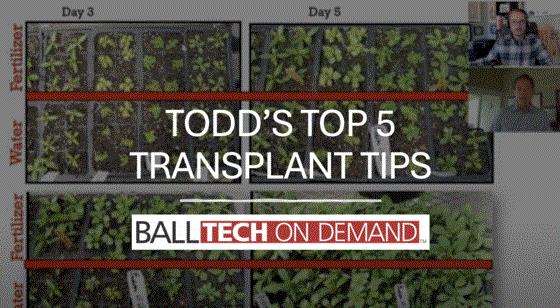
Check out this discussion with Tech On Demand expert Dr. Todd Cavins about best practices related to transplanting plugs and liners. In it, you’ll learn Todd’s Top 5 Transplant Tips:
-
Don’t delay!
-
Apply fungicide in the plug or liner tray
-
Carefully manage plug and liner moisture at transplant
-
Feed your transplants—nutrition is key!
-
Cycle your irrigation
Watch this VIDEO for all of the details, trial photos, a time-tested feeding method and much more. The video has more than 1,000 views, which tells me it’s a good one!

Nick’s Tip of the Week: Edema Showing Up Early in 2024
Each week, I’ll work with my buddy Nick Flax, a technical services expert at Ball, to share a concern that’s come up during one of his numerous calls with growers across North America. This week he’s highlighting a disorder that seems to be impacting crops earlier this year—probably due to crazy weather patterns.
PROBLEM: In about a month, your greenhouses will be stacked to the rafters with plants, and multitudes of problems pop up when you have so many different crops tightly packed in the same greenhouse. But a recent trend in the questions I am getting has put a spotlight on two common disorders that always seem to pop up around this time each year.
In fact this year, due to the odd weather fluctuations we’re all seeing, the problems detailed below seem to be occurring earlier than usual. The Tech On Demand team has been fielding such calls for the past week or so.
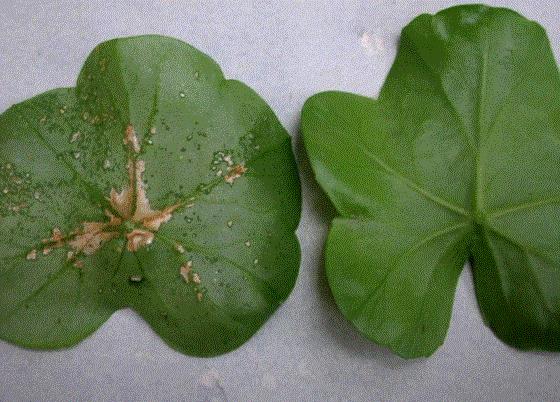
Photo: Cornell University
NICK’S TIP: Let’s take a look at two timely physiological disorders, how to manage them, and why you shouldn’t worry too much if they show up in your crops.
Intumescence
While occurrences have been linked to a lack of UVB radiation in greenhouse environments during crop production, it’s still not 100% clear why intumescence occurs. However, this disorder results in some concerning symptoms—especially if you aren’t familiar with how to identify it—and growers are often (and understandably) freaked out when they see it for the first time.
-
Early symptoms often present as rows of bumps or “pustules” along stems, leaf petioles and midribs. Depending on the crop, lesions may range in color from light to dark, and sometimes translucent.
-
When symptoms are severe, lesions can coalesce into masses and oftentimes appear more broadly across the undersides and even on tops of leaves. As lesions mature, they often become darker in color and eventually take on a corky color and eventually become blackish-brown as the tissue senesces.
-
Intumescence is known to affect several crops, but sweet potato vine (Ipomoea batatas) and Black-eyed Susan vine (Thunbergia alata) are two of the most frequently reported. Tomato (Solanum lycopersicum) and Cuphea spp. are also more common victims of this disorder.
-
Lesions on Thunbergia, Cuphea and tomato are most often circular or spherical, while lesions on Ipomoea are often more angular or geometric in appearance when viewed under magnification.
-
At first glance, many growers mistake intumescence lesions as insect eggs, fungal spots or crown gall (Agrobacterium tumefaciens). However, if you see symptoms in your greenhouse on one or two of the crops mentioned in this week’s tip and not on anything else, it’s most likely just intumescence.
-
Some varieties are more prone to intumescence, so make note of any varieties that seem to be more affected than others in your operation. If customers express concerns or any of your crops are unsalable due to unsightly symptoms, it may be wise to avoid growing these varieties in the future.
While this is certainly an unsightly disorder, it won’t negatively impact overall development and health of the crop. Affected plant parts do not recover (lesions don’t disappear) but new growth tends to be less and less affected as spring progresses. If you receive young plants that have intumescence symptoms, don’t worry, they can be grown on to maturity without issue. Some selective cleanup and removal of affected leaves before plants hit retail may be advisable but be sure to wait until new growth is symptom-free before doing so.
Check out these awesome e-GRO Alerts on intumescence of Ipomoea and Thunbergia for some great photos and more details.
Edema … or oedema if you’re feeling fancy …
This is another physiological disorder that often afflicts crops earlier in spring, but the reason it happens is much better understood, which means it can be more easily managed. Edema occurs when turgor pressure (internal water pressure in plant cells) gets too high, which causes cells to rupture. The earlier you can catch edema symptoms and make necessary corrections, the better.
-
Water-soaked lesions on the undersides of leaves are one of the earliest symptoms. However, once ruptured epidermal cells have closed and lesions are no longer wet looking, they often resemble thrips damage.
-
As ruptured cells heal, they often take on a corky color. In severe cases, damaged cells develop into callused masses that resemble blisters. These blisters are almost always on the undersides of leaves and not visible from above, so growers often confuse this with rust, Agrobacterium or mite damage when it occurs.
-
Geraniums, particularly ivy geraniums (Pelargonium peltatum), are one of the most edema-prone spring bedding plants. Much like intumescence, some varieties are more sensitive to edema than others.
-
Edema occurs most often when substrate moisture levels remain high for extended periods and weather is cloudy and/or relative humidity is high. Be sure to avoid overwatering and allow for thorough wet-to-dry cycles between irrigation events to reduce this tendency.
-
Increase air flow in the greenhouse to encourage transpiration, even if weather conditions make reducing relative humidity challenging. A little more air movement can make a big difference to reduce edema incidences and severity.
Mild edema seldom affects overall growth and quality of plants, and symptoms subside as weather improves, but severe damage can cause reduce aesthetic quality and cause leaf senescence. Geraniums with lots of senescent leaves can rapidly become Botrytis factories, so be sure to clean up heavily edema-damaged foliage ASAP and apply a broad-spectrum fungicide as a protectant, if necessary.

More Edema Tips … Specifically on Begonia
Here’s some follow-up info on edema that reared its ugly head in a begonia crop last spring. Take a look at the progression in the photos and advice about how to take action.
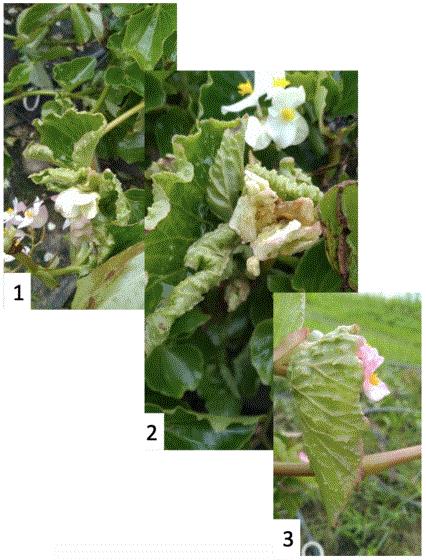
When Tech On Demand experts saw the symptoms, they agreed it appears to be edema. Also, the grower was advised to look for low Calcium and Boron, which would happen with edema conditions, such as high relative humidity.
-
High relative humidity (RH) causes low evaporation, leading to lower uptake of Ca and B and increased edema risk.
-
Ca/B deficiency results in brown leaf edges, crinkled/cupped leaves and malformed flowers like you see in photos 1 and 2.
Signs of edema (oedema), a common physiological disorder, vary between susceptible species. They often include bumps, blisters or water-soaked areas on the undersides of leaves. These areas may expand and become corky, but in other plants, curling and distortion are common. White, crusty eruptions may form along the leaf veins or gall-like structures can develop under leaves with yellow corresponding spots on the upper leaf surface like you see in photo 3.
Here are some tips to avoid these problems under high RH conditions. Stimulate evaporation of the plants by:
-
Creating air movement in the greenhouse to reduce RH around the plant by using HAF or opening the vents.
-
Keeping the media slightly dry, especially at the end of the day. Try to avoid going into the night with wet (Level 4) growing media.
-
Applying enough (extra) Ca and B with your fertilizer solution.
-
Using drip irrigation instead of overhead watering to avoid wet foliage.

VIDEO: Identifying Broad Mites
In last week’s NEWSLETTER, Nick dug deep into broad mites on New Guinea impatiens, focusing on look-alike symptoms to be aware of and some of the more common mix-ups. He spent a lot of time/words on broad mites versus high EC, while explaining why looking for patterns in your crops will go a long way toward correctly diagnosing whether or not broad mites are the problem to address.
Leanne Pundt, an extension educator at University of Connecticut Extension who focuses on commercial greenhouse crops, reached out via a Ball Seed sales rep in her region to share a fantastic VIDEO produced by UConn showing—visually—how to identify broad mites and their damage.
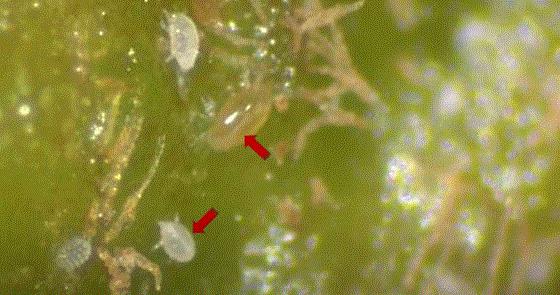
The three-minute video shows symptoms on various crops, as well as close ups and microscope footage of the pests in action. This is an excellent video to share with your production team and pest scouts to help correctly identify broad mites if (or when) they show up in your greenhouse.
Note: The video is also available in SPANISH.

Grouping Crops After Transplanting
Following up on Todd’s tips from the beginning of this newsletter, I came across an excellent FACT SHEET from the University of Massachusetts extension research group. The information presented is focused on best practices for managing plugs from the moment they’re delivered to your greenhouse through the transplant stage. Of particular interest is the advice given by researchers on how to group plants in the best environments, based on their cultural differences.
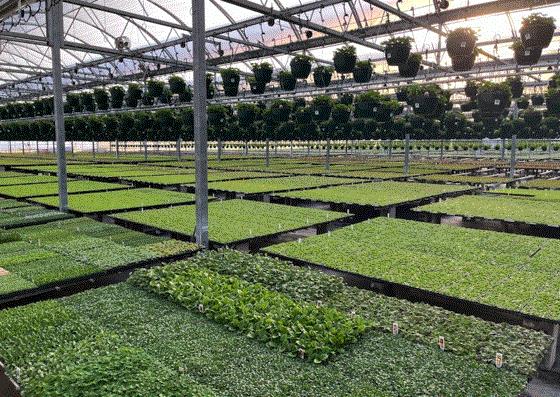
Dr. Claudio Pasian, Horticulture and Crop Science, Ohio State University, offers suggestions for grouping crops. Crops can be divided (and grown apart) based upon two environmental characteristics: temperature and substrate pH—the goal being to place plants into the proper environment.
Some crops can be grown at lower temperatures than others. For example, grouping crops that can be grown cool such as nemesia, bacopa, snapdragon, diascia, scaevola and osteospermum separately from crops that need warmer temperatures such as geraniums, begonias and New Guinea impatiens will allow cool crops to be grown at lower temperatures and save on energy costs. The cool crops can be sold earlier, or moved outdoors for finishing, making room for later plantings.
Within the temperature groups, crops can then be separated based on their substrate preferences. Paul Fisher, University of Florida, and Bill Argo, Blackmore Company, have divided crops into three distinct groups 1. Geranium 2. General and 3. Petunia, based on their efficiency to pick up iron from the substrate.
-
Geranium group (pH range of 6.0-6.6) includes plants that are efficient at taking up iron such as lisianthus, marigold, New Guinea impatiens and seed and zonal geraniums.
-
General Group (pH range of 5.8-6.4) includes begonias, chrysanthemums, ivy geraniums and impatiens.
-
Petunia group (lower pH range 5.6-6.2) includes plants that are inefficient at taking up iron. The petunia group includes calibrachoa, scaevola, snapdragon, bacopa and argyranthemum.
Once plants are grouped according to temperature, crops can then be grouped based on their response to substrate pH, and they can then be treated differently according to their needs. For example, it is possible to have different injectors in different zones using different fertilizer types: acidic for the petunia group and neutral or basic, or perhaps liquid lime application for the geranium group.
Grouping plants may be more easily said than done, however. Before transplanting think about how to efficiently manage space and group crops to produce high-quality crops.

Finish Line ...
 My, how time flies!
My, how time flies!
In a few short weeks, your friendly neighborhood Bobbleheads will head west for California Spring Trials to cover all of the key stops and share the latest and greatest in new varieties and concepts. I was in the West Chicago office earlier this week and I met with Chris, Jen and Osvaldo to talk through our video strategy, and that got me really excited!
Hopefully some of you are also planning to make the trip. If so, be sure to check out our CALIFORNIA SPRING TRIALS website for all the details, including trial stops, lodging and restaurant ideas.
If you’re not heading west this year, you can follow us up the coast via our daily newsletter, packed with our takes on the varieties we see each day, as well as the videos you’ve come to know and (I hope) love. Sign up to receive ACRES OF BUZZ to get our five days of reports.
Talk to you next week!
Please feel free to send your comments, constructive criticism and topic ideas to me at bcalkins@ballhort.com.

Bill Calkins
Editor - Tech On Demand
This email was received by you and 25,960 other fine subscribers!
If you're interested in advertising in Tech On Demand, contact Kim Brown ASAP and she'll hook you up.